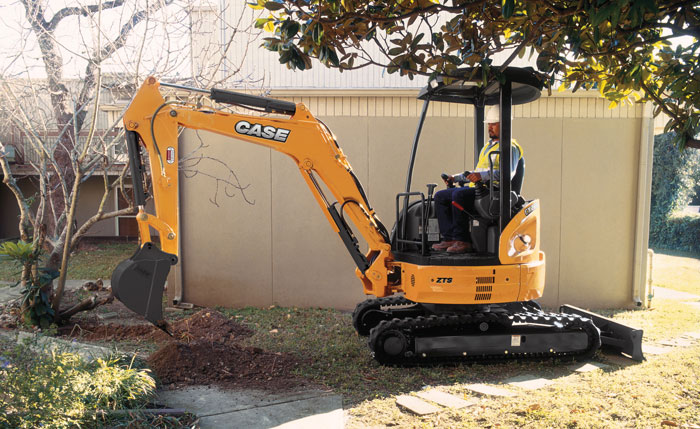Mini Ex Track Choices

Whether digging, loading or dozing, a compact excavator is an extremely versatile machine. Key to its performance is the machine’s tracks, which is why knowing track basics helps ensure optimal machine performance and longevity.
The Two Main Options: Rubber and Steel
Rubber and steel tracks are the two main options for most compact excavators. Each fulfills a distinct need based on the application involved. Rubber tracks are the most commonly used tracks because compact excavators are mostly used in finished areas where potential damage to surfaces caused by the tracks must be kept to a minimum. This includes jobs such as ponds, swimming pools and running electrical or plumbing lines. There is less chance for damage on surfaces like lawns, sidewalks and asphalt when using rubber tracks because rubber “gives” more than steel. Additionally, rubber tracks traditionally have a wider surface area than steel tracks. As such, they distribute the weight of the machine over a larger surface area for lower ground pressure.
Thinner, yet strong surface steel tracks dig into the ground more than rubber tracks do. They’re used when damage to the surface is less of a concern and better grip is needed, which is the case with loose dirt and similar applications. Steel tracks are used instead of rubber tracks in many heavy-duty applications, such as recycling, demolition and road/bridge work because the steel can withstand more wear and tear than rubber — especially when it comes to traveling over sharp objects or stones. A steel track will generally last longer than a rubber track.

Other options are available in addition to standard rubber and steel tracks for added machine versatility. These include:
- Turf-style rubber tracks: They disturb the ground even less than standard rubber tracks and are ideal when no surface damage is the goal.
- Wide tracks: With the weight and pressure of the machine more widely distributed than a standard-width track, the result is lower ground pressure and less disturbance of the surface. A wide track also provides a high level of flotation when needed, such as in wet and muddy conditions.
- Combination tracks: These consist of steel tracks with removable rubber pads bolted to each section. The main advantage is versatility since the pads can be changed out relatively easily and quickly.
- Hydraulic retractable tracks: Some machines allow the operator to retract the tracks to move through a narrow opening. The tracks can then be expanded again to maintain digging power and stability.
Keeping Things in Good Working Order
Tracks are wear parts that need regular attention. Tips for keeping the tracks in good working condition and the machine up and running are as follows:
- Track tension: Check it after every 10-15 hours of use. If it’s too loose, the operator can literally drive out of the tracks. Excessive track wear also results if it’s too tight.
- Wash down and walk-around: Wash the machine down at the end of each day. Do a walk-around and notice any missing or damaged components that need to be replaced. Watch for rips or tears in rubber tracks, which should be replaced before they fail.
- Cleaning and greasing: Remove dirt, debris and rocks from the tracks and undercarriage. Keep the undercarriage greased.
- Tread carefully: Go easy with rubber tracks. For example, use the machine mostly on soft surfaces. Also, drive straight across hard surfaces and then turn on softer ones. Inspect rubber tracks after traveling over sharp objects.
- Slow down and minimize travel times: Lower speeds will minimize wear and tear, as will fewer quick and sharp turns. Also avoid unnecessary travel.
Katie Pullen is the brand marketing manager with Case Construction Equipment, based in Racine, Wis.




